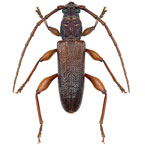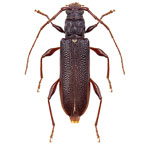Callidiopis
Thomson
Cerambycinae
Callidiopis Thomson, 1864: 237. Type species: Callidium scutellare Fabricius, 1801.
Diagnosis
Small to medium-sized dark brown beetles with filiform antennae reaching almost to apices of elytra. Frontoclypeus transverse. Gland opening at base of mandibles absent. Eyes moderately coarsely facetted, deeply emarginate. Antennal tubercles broadly separated, distant from mandibular articulation. Antennal foramen depressed. Antennal scape distinctly shorter than pronotum; pedicel as long as wide; antennomere 3 longer than scape; antennomeres 3–7 with short apical spines or prominent angles. Pronotum subquadrate with dorsal nodules, lateral margins rounded. Prosternal process moderately broad, weakly expanded apically. Procoxal cavities rounded without lateral extensions; open externally. Procoxae weakly projecting below prosternal process. Mesoventrite flat in front of mesocoxae; mesoventral intercoxal process broad, without secondary articulation, notched apically. Mesocoxal cavities closed to mesepimeron; mesotrochantin hidden. Elytra without costae or ivory-coloured markings; punctures clearly visible not in regular rows, apices rounded. Femora strongly clavate; tibiae not flattened.
Distribution and Biology
Callidiopis is an endemic Australian genus known from south-eastern Australia, where it ranges from the New England Tablelands in New South Wales, via the Australian Capital Territory to Tasmania and to the Flinders Ranges of South Australia. Callidiopis scutellaris was introduced to New Zealand at the beginning of the 20th Century and is currently the most common cerambycid associated with dead Eucalyptus material in New Zealand.
Australian Species
mutica Lacordaire
Callidiopsis mutica Lacordaire, 1868: 357.
praecox (Erichson)
Stenocorus praecox Erichson, 1842: 220.
scutellaris (Fabricius)
Callidium scutellare Fabricius, 1801: 338.
References
Erichson, W.F. 1842. Beitrag zur Insecten-fauna von Vandiemensland, mit besonderer Berucksichtigung der geographischen Verbreitung der Insecten. Archiv für Naturgeschichte 8(1): 83–287, pls 4, 5.
Fabricius, J.C. 1801. Systema Eleutheratorum secundum ordines, genera, species: adiectis synonymis, locis, observationibus, descriptionibus. Kiliae : Bibliopolii Academici Novi Vol. II 687 pp.
Lacordaire, J.T. 1868. Histoire naturelle des insectes. Genera des Coléoptères. Tome 8. Contenant les familles des Tricténotomides et des Longicornes. Paris : Librairie Encyclopédique de Roret pp. 1–552.
Thomson, J. 1864. Systema cerambycidarum ou exposé de tous les genres compris dans la famille des cérambycides et familles limitrophes. Liége : H. Dessain 578 pp.

